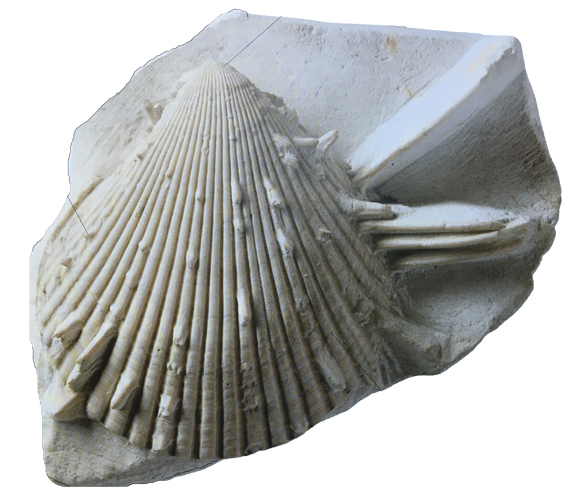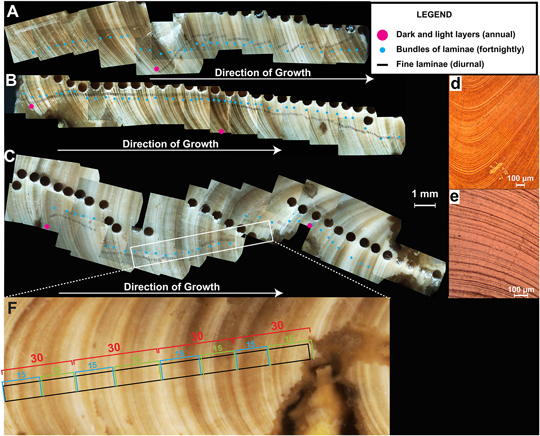Fossil Clam Helps Scientists to Tell the Time
Researchers from the Vrije Universiteit Brussel and the University of Ghent have used 70 million-year-old fossil bivalves to gain information about day length and seasonal variations during the Late Cretaceous. tyrannosaurids and duck-billed dinosaurs had days that were approximately 30 minutes shorter than ours, as a consequence of this their year was about a week longer.
Writing in the academic journal Paleoceanography and Paleoclimatology, the researchers conducted a series of tests on the fossilised shells of a type of bivalve (Torreites sanchezi). The fossil was found on a mountainside in Oman, but back in the Campanian stage of the Late Cretaceous, this area was a shallow, subtropical sea.
Daily Growth Rings Preserved in Fossil Bivalves Can Provide Scientists with Data About Ancient Planetary Systems

Picture credit: Everything Dinosaur
Laser Used to Bore a Hole in the Shell
Many types of molluscs grow quickly and they lay down discernible growth rings on their shells every day. Scientists can conduct a series of tests on these markers and identify useful information about the climate and the environment in which the mollusc lived. For example, using the growth rings, the researchers were able to determine that the fossil specimen died when it was around nine years of age.
A laser was used to bore a series of tiny holes in the shell, samples were taken and analysed for trace elements. Using this information, the scientists were able to gain information on the temperature and the chemistry in the sea water in the reef environment where the mollusc lived. The marine temperatures fluctuated between summer and winter, with a peak of around 40 ˚ Celsius in summer and 30 ˚ Celsius in winter. The average annual sea temperatures were warmer than previously thought.
The Rings on the Bivalve Shell Can Provide a Lot of Information

Picture credit: Niels de Winter et al
Determining the Growth Rate of a Fossil Bivalve
In addition, the scientists determined that the bivalve grew much faster during the day than it did at night. This phenomenon is not uncommon with bivalves today, some species form symbiotic relationships with algae, it is thought that the Cretaceous species was in a similar relationship. A combination of counting layers, spectral analysis of chemical cyclicity and chemical layer counting shows that the mollusc laid down 372 daily laminae per year, demonstrating that length of day has increased since the Late Cretaceous, as predicted by numerous astronomical models and previous studies of fossil molluscs.
However, this study represents the most accurate assessment of seasonal growth, day length and annual environmental changes recorded in a fossil from the Late Cretaceous.
The Earth’s orbit around the sun does not alter that much, the extra 7 days recorded in a year, are not really a record of the Earth taking longer to make its orbit, but a reflection of the fact that the Earth was spinning faster on its axis 70 million years ago. With the Earth turning faster, a day was slightly shorter compared to what we experience in the 21st century. A day in the Cretaceous would have lasted approximately 23 1/2 hours.
An Explanation – Why is the Rotation of the Earth Slowing Down?
The Earth’s orbit around the sun does not change a great deal, but the length of a day on Earth has been steadily increasing since our planet and its moon were formed. The moon’s gravity is acting on our planet, it creates friction from ocean tides and this is gradually slowing the Earth’s rotation. At the same time, Earth’s own gravity is having an effect on the moon. The pull of the tides accelerates the moon, so the satellite is being pushed away from our planet.
When the Torreites sanchezi bivalve was alive, a dinosaur on the beach at night would have seen a moon that looks bigger than the one we see today, it was several thousand metres closer to Earth.
The research team conclude that as bivalve shell calcite preserves quite well, this study permits further work using other fossils to determine seasonality, marine temperatures and day length. This should help to document environmental change in warming ecosystems and widen our understanding of the magnitude of short‐term changes during greenhouse climates.
The scientific paper: “Subdaily-Scale Chemical Variability in a Torreites sanchezi Rudist Shell: Implications for Rudist Paleobiology and the Cretaceous Day-Night Cycle” by Niels J. de Winter, Steven Goderis, Stijn J.M. Van Malderen, Matthias Sinnesael, Stef Vansteenberge, Christophe Snoeck, Joke Belza, Frank Vanhaecke, and Philippe Claeys published in Paleoceanography and Paleoclimatology.
Visit the Everything Dinosaur website: Everything Dinosaur.






Leave A Comment